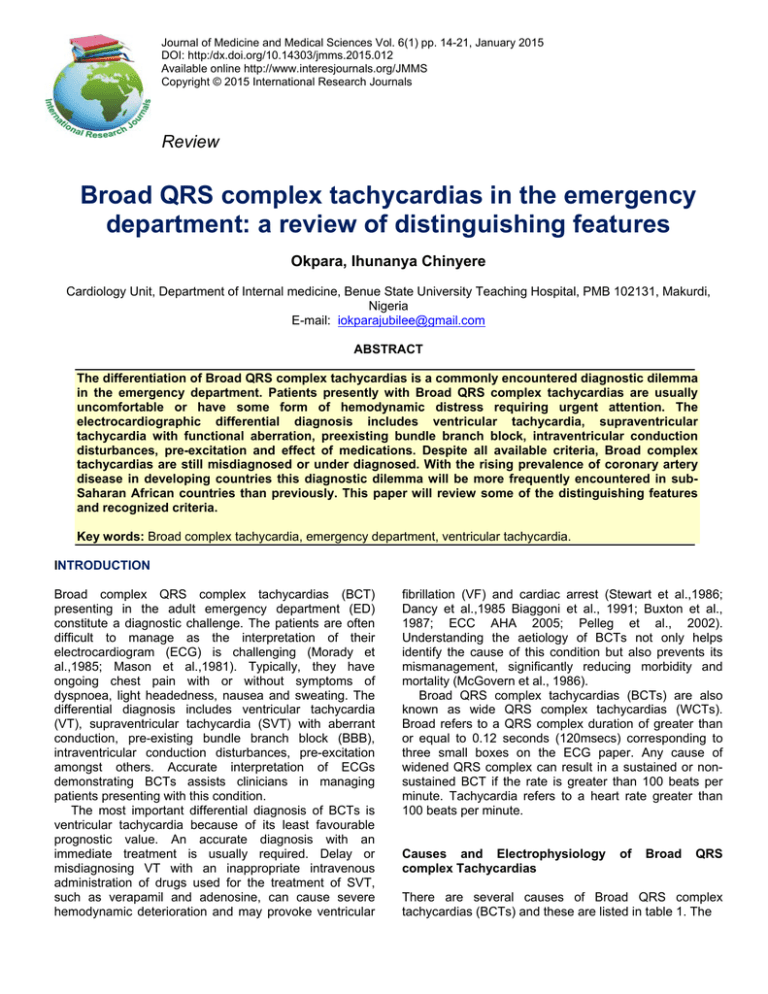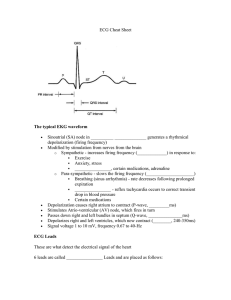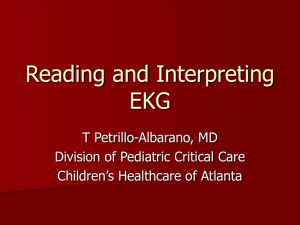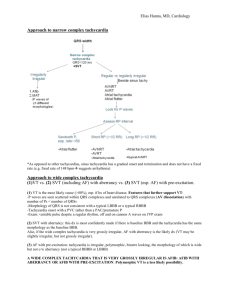Document 14233435
advertisement

Journal of Medicine and Medical Sciences Vol. 6(1) pp. 14-21, January 2015 DOI: http:/dx.doi.org/10.14303/jmms.2015.012 Available online http://www.interesjournals.org/JMMS Copyright © 2015 International Research Journals Review Broad QRS complex tachycardias in the emergency department: a review of distinguishing features Okpara, Ihunanya Chinyere Cardiology Unit, Department of Internal medicine, Benue State University Teaching Hospital, PMB 102131, Makurdi, Nigeria E-mail: iokparajubilee@gmail.com ABSTRACT The differentiation of Broad QRS complex tachycardias is a commonly encountered diagnostic dilemma in the emergency department. Patients presently with Broad QRS complex tachycardias are usually uncomfortable or have some form of hemodynamic distress requiring urgent attention. The electrocardiographic differential diagnosis includes ventricular tachycardia, supraventricular tachycardia with functional aberration, preexisting bundle branch block, intraventricular conduction disturbances, pre-excitation and effect of medications. Despite all available criteria, Broad complex tachycardias are still misdiagnosed or under diagnosed. With the rising prevalence of coronary artery disease in developing countries this diagnostic dilemma will be more frequently encountered in subSaharan African countries than previously. This paper will review some of the distinguishing features and recognized criteria. Key words: Broad complex tachycardia, emergency department, ventricular tachycardia. INTRODUCTION Broad complex QRS complex tachycardias (BCT) presenting in the adult emergency department (ED) constitute a diagnostic challenge. The patients are often difficult to manage as the interpretation of their electrocardiogram (ECG) is challenging (Morady et al.,1985; Mason et al.,1981). Typically, they have ongoing chest pain with or without symptoms of dyspnoea, light headedness, nausea and sweating. The differential diagnosis includes ventricular tachycardia (VT), supraventricular tachycardia (SVT) with aberrant conduction, pre-existing bundle branch block (BBB), intraventricular conduction disturbances, pre-excitation amongst others. Accurate interpretation of ECGs demonstrating BCTs assists clinicians in managing patients presenting with this condition. The most important differential diagnosis of BCTs is ventricular tachycardia because of its least favourable prognostic value. An accurate diagnosis with an immediate treatment is usually required. Delay or misdiagnosing VT with an inappropriate intravenous administration of drugs used for the treatment of SVT, such as verapamil and adenosine, can cause severe hemodynamic deterioration and may provoke ventricular fibrillation (VF) and cardiac arrest (Stewart et al.,1986; Dancy et al.,1985 Biaggoni et al., 1991; Buxton et al., 1987; ECC AHA 2005; Pelleg et al., 2002). Understanding the aetiology of BCTs not only helps identify the cause of this condition but also prevents its mismanagement, significantly reducing morbidity and mortality (McGovern et al., 1986). Broad QRS complex tachycardias (BCTs) are also known as wide QRS complex tachycardias (WCTs). Broad refers to a QRS complex duration of greater than or equal to 0.12 seconds (120msecs) corresponding to three small boxes on the ECG paper. Any cause of widened QRS complex can result in a sustained or nonsustained BCT if the rate is greater than 100 beats per minute. Tachycardia refers to a heart rate greater than 100 beats per minute. Causes and Electrophysiology complex Tachycardias of Broad QRS There are several causes of Broad QRS complex tachycardias (BCTs) and these are listed in table 1. The Okpara 15 Table 1: Causes of a Broad QRS Complex Tachycardia S/No. Causes of a Broad QRS Complex Tachycardia 1 Supraventricular tachycardia (SVT) with preexisting LBBB 2 Supraventricular tachycardia (SVT) with aberrant conduction 3 Atrial fibrillation with Wolff Parkinson White syndrome (WPWS) 4 Ventricular tachycardia (VT) 5 Polymorphic VT (Torsades de pointes) 6 Pacemaker mediated tachycardia (PMT) 7 Drug induced (digitalis, TCA, Cocaine, Lithium 8 Sodium channel blocking agents 9 Hyperkalemia LBBB = Left Bundle Branch Block TCA = Tricyclic Antidepressants QRS complex is the electrical stimulus on the ECG tracing as it passes from the AV node down the ventricular conduction system, terminating in the ventricular myocardial cells (Dubin, 1970). This is the normal pathway for cardiac conduction. Pre-excited Supraventricular Tachycardia including Wolff Parkinson White Syndrome (WPWS) An understanding of the electrophysiology behind BCTs assist clinicians with decision analysis and explanation of the abnormal conduction. Situations often exist during which a normal pathway of cardiac conduction does not occur. When this happens, the QRS complexes may appear different, having increased duration or width. This situation occurs in pre-excitation of the ventricles. Here the normal electrical impulse originating from the atria reaches ventricular tissues earlier than expected by means of an accessory pathway. This impulse bypasses the AV node, which eliminates AV nodal delay and allows for earlier activation of the ventricles. The three most common accessory pathways identified are the Kent bundle (AV bypass tracts), responsible for the Wolff- Parkinson- White Syndrome (WPWS), the James’ responsible for the syndrome known as LownGanong-Levine, and the Mahaim bundles (nodoventricular fibers). These accessory pathways each result in ventricular tissue receiving activation from a supraventricular source earlier than expected. In Wolff – Parkinson White Syndrome, this premature activation results in a short PR interval (<0.12seconds) a broad QRS complex with a slurred initial upstroke known as a delta wave (figure 1). The latter is the result of partial premature activation of ventricular tissue from the Kent accessory bundle combined with the majority of ventricular activation via the normal conduction pathway (Moore and Munter, 1989). If atrial fibrillation occurs, it may produce dangerously rapid ventricular rate because the accessory pathway lacks the rate limiting properties of the atrioventricular (AV) node. This is known as preexcited atrial fibrillation and may cause collapse, syncope and even death. In this situation, antiarrhythmic agents that shorten the refractory period of the accessory pathway such as Digoxin and Verapamil should be avoided (McGovern et al., 1986). Ventricular Tachycardias Ventricular tachycardia (VT) is caused by abnormal automaticity or triggered activity in ischemic tissue, or by re-entry within scarred ventricular tissue. The ECG shows tachycardia with broad, abnormal QRS complexes with a rate >120/min (figure 2). Broad QRS Complex Tachycardia antiarrhythmic drug treatment during Antiarrhythmic drugs (AADs) especially those that slow conduction like class IC drugs may cause proarrythmias represented by monomorphic VT. On the other hand, class IC AADs may cause bizarre aberrant conduction during SVT which may mimic VT (Crijins et al., 1988). The QRS complex during aberration is characterized by a QRS duration between 180 and 240ms and bizarre right bundle branch block (RBBB) with a right or extreme axis deviation or atypical left bundle branch block (LBBB) with left axis deviation. The explanation of the occurrence of 16 J. Med. Med. Sci. Figure 1: Supraventricular conduction(WPWS) tachycardia (SVT) with aberrant WPWS = Wolff-Parkinson-White syndrome. Note positive delta wave in anterior leads V1, V2 and V3 Figure 2: Ventricular Tachycardia(VT). Ventricular Tachycardia (VT). Note the Fusion beat in lead aVF indicated by arrow bizarrely shaped BBB during treatment with class IC AADs particularly Flecainide, is yet uncertain. A possible explanation is the occurrence of use dependent conduction delay especially in the myocardium beyond the block (Crijins, 1993). Bundle Branch Tachycardia and Interfascicular Reentry These are uncommon forms of VT usually seen in patients with an acquired heart disease and significant Okpara 17 conduction system impairment. The surface ECG insinus rhythm. Characteristically shows intraventricular conduction defects with or without PR interval prolongation. A relatively narrow baseline QRS complex suggests a role of functional conduction delay in the genesis of bundle branch reentry. The QRS morphology during VT is a typical BBB pattern, usually LBBB, and may be identical to that in sinus rhythm (Caceres et al., 1989; Cohen et al., 1991; Blanck et al., 1993; Mehdirad et al., 1995). In contrast to VT of myocardial origin, bundle branch reentry with LBBB pattern characteristically shows rapid intrinsicoid deflections in the right precordial leads, indicating that initial ventricular activation occurs through the specific conduction system. Interfascicular tachycardia has been less commonly reported. This tachycardia usually has an RBBB morphology. The orientation of the frontal plain axis is variable and may depend on the direction of the reentrant circuit. Anterograde activation over the left anterior fascicle and retrograde through the posterior fascicle would be associated with right axis deviation and the reversed activation sequence with left – axis deviation (Crijins et al., 1995). Role of history and physical examination Several aspects of the medical history contribute to the clinician’s ability to identify the etiology behind a BCT. Individuals with previous myocardial infarction (MI) or known coronary artery disease (CAD) are approximately four times more likely to present with ventricular rather than supraventricular aetiologies of their BCT. Ventricular tachycardia is the most common cause of BCTs accounting for 80% of cases. This figure maybe higher than that seen in patients presenting to the ED, due to referral bias at specialty centers and the repeated citation of older literature (Akhtar et al., 1988). One small retrospective study found that, histories of prior myocardial infarction (MI), congestive heart failure (CHF), and recent angina pectoris all had positive predictive values for VT greater than 95%, but sensitivities were low to moderate (Baerman et al., 1987). None of these clinical characteristics were strongly predictive for SVT for which the best was age less than or equal to 35years (positive predictive value of 70%) (Tchou et al., 1988). Cardiovascular signs and symptoms during tachycardia such as palpitation, syncope, angina, hypotension are important in indicating the hemodynamic state of the patients but they are not helpful in determining the mechanism of the tachycardia (Morady et al., 1985; Tchou et al., 1988). Vagal maneuvers such as cautious carotid sinus massage (CSM), gagging or coughing, and valsalva can slow the ventricular response in many tachycardias of supraventricular origin, allowing atrial activity to be more apparent. Mostly, VT does not respond to CSM or vagal maneuvers. However cyclic-AMP related VT that terminates with CSM has also been reported (Alzard et al., 2009). Atrioventricular Dissociation During a careful physical examination, identifying signs of atrioventricular (AV) dissociation strongly supports the diagnosis and electrophysiology of VT. AV dissociation occurs due to independent activity of atria and ventricles, a characteristic occurrence in VT. Physical signs include irregular cannon A waves, varying intensity of the first heart sound (S1), and beat – to beat variability in systolic blood pressure (SBP). Other Clinical Features The most important point to consider when evaluating and treating individuals presenting with BCTs is their hemodynamic status. Symptoms providing evidence of unstable BCTs include hypotension, pulmonary oedema, confusion, angina. An individual’s hemodynamic status does not help to determine the etiology of the BCT. An approach in which clinicians err on the side of caution by considering someone hemodynamically “unstable” is most prudent. It is incorrect to consider only VT as unstable or that SVTs of any etiology do not cause hemodynamic compromise. Many patients with known cardiac histories especially those with rhythm disturbances take antiarrhythmic medications. These agents have various effects on cellular electrophysiology and are divided using the Vaughan – Williams international classification system. Most of these agents prolong the duration of various portions of the ECG including the QRS complex and are proarrhythmic. Thus a thorough history of medications is important. For patients with permanent pacemaker, part of the physical examination diagnostics includes careful placement of a pacemaker magnet over a pacemaker generator. In patients presenting with a BCT, the magnet converts the pacemaker’s pulse generator from the synchronous (demand) to asynchronous (fixed or “magnet” rate) mode of response. This action may allow identification of atrial activity. If this BCT is pace-maker mediated, the magnet is likely to terminate the abnormal rhythm (Barber and Garme, 1997). The Role of the Electrocardiogram in Broad Complex Tachycardias In addition to history and physical examination, there exist clues on the ECG that help to determine the aetiology of BCTs. 18 J. Med. Med. Sci. Electrophysiology of the abnormal rhythm Precordial Concordance A very regular rhythm tends to favour the diagnosis of SVT with aberrant conduction as the cause of the BCT. A markedly irregular rhythm favours atrial fibrillation (AFIB) with aberrant conduction, such as a pre-existing Bundle Branch Block (BBB) or Wolff-Parkinson-White Syndrome (WPWS). Previous ECGs may provide essential information, such as prior rhythm pattern (normal sinus, AFIB, SVT or VT) or previous QRS morphologies (BBB patterns, evidence of WPWS or structural heart disease). Precordial concordance means that the QRS ‘direction’ on the ECG in all the precordial leads is consistent. Positive precordial QRS concordance may occur during VT or SVT using a left posterior accessory pathway for AV conduction. Therefore positive does not discriminate between VT and SVT with aberration. Negative precordial concordance is nearly always VT, because, anti-dromic circus movement tachycardia never has negative precordial concordance. According to Wellens, this is true since accessory pathways over which anterograde conduction leads to completely negative QRS complexes in all the leads do not exist (Wellens and Conover, 1992). However, a recent report of an 11year old male demonstrated that this ‘rule’ is not perfect, as his underlying pectus excavatum and SVT withLBBB resulted in a BCT with negative precordial concordance due to SVT with aberrant conduction (Volders et al., 2003). This observation led the authors to conclude that no diagnostic technique is perfect and that there are always exceptions to the rule and electrophysiology (Kappos et al., 2006). Electrocardiographic detection of AV dissociation AV dissociation, although not commonly identified are very sensitive for VT. AV dissociation is generally detectable in a lead where the P-wave is most prominent whether anterograde or retrograde. This lead is usually one of the inferior leads considering the lead in which the QRS complex is the most modest. This is the lead least interfering with the relatively prominent P-wave. In AV dissociation the P-waves and QRS complexes classically lack any relationship meaning that there is no association between them. QRS variability can also indicate AV dissociation. The mechanism of changes in the QRS amplitude is not completely clear. The most probable explanation is that the QRS voltage is determined by the variability of ventricular filling and volume. Additionally, super-imposition of the P-wave in the R-wave or mechanical factors such as changes in the ventricular position within the thorax following different atrial contractions may play a role. Fusion and Capture Beats Fusion and capture beats are helpful in diagnosing VT though not always present. Fusion beats are hybrid QRS complexes resulting from simultaneous supranodal (atrial) and infranodal (ventricular) activation of ventricular tissue. The conducted impulse from atrial tissue fuses with the tachycardia originating from ventricular tissue forming a fusion beat as shown in figure 2. Capture beats are QRS complexes resulting in ventricular activation originating from supranodal tissue, using normal electrical conduction pathways above the ventricle. A ‘normal’ sinus beat is produced in the middle of the tachycardia. These are therefore narrow and are similar (or identical) to a ‘normal’ QRS complex. Fusion and capture beats can only occur when there is AV dissociation and thus are diagnostic of VT. The Electrical Axis Some researchers claim that the QRS axis helps determine the aetiology of a BCT. ECG leads placed on the body create Einthoven’s triangle, which can be used to determine the overall electrical axis of a patient. The quadrant in which the QRS axis found may provide additional support that the BCT pattern is due to VT. Electrocardiographic criteria for determining origin of BCTs The three most well accepted criteria for the interpretation of BCTs based on the 12 lead ECG are the Wellen’s criteria (Wellens et al., 1978) (table 2), Kindwall’s 4 electrocardiographic criteria for VT in LBBB (Kindwall et al., 1988) (table 3), and the Brugada’s 4 step approach (Brugada et al., 1991; Antunes et al., 1994) to regular tachycardias with wide QRS complexes (table 4). Also included is a table using morphologic criteria of the ECG and its associated bundle branch pattern (positive and negative deflections) of the QRS (table 5). The classification schemes based on QRS morphology are essentially the same; both are included because some individuals prefer classifying the BCT ECGs as RBBB – like or LBB – like (Table 6). Others prefer to consider BCT ECGs according to V1(V2) – positive or negative Okpara 19 Table 2: Wellen’s Criteria S/No. 1 2 3 4 5 6 Wellen’s Criteria (VT favoured in the presence of) AV dissociation Left Axis Deviation Capture or Fusion beats QRS duration greater than 140m seconds Precordial QRS concordance RSR’ in V1, mono or biphasic QRS in V3 or monophasic QS in V6 Table 3: Kindwall’s ECG criteria for VT in LBBB S/No. 1 2 3 4 Kindwall’s ECG criteria for VT in LBBB R wave in V1 or V2 of greater than 30mseconds duration Any Q wave in V6 Duration of greater than 60m seconds from the onset of the QRS to the nadir of the S wave in V1 or V2 Notching on the downstroke of the S wave in V1 or V2 VT = Ventricular Tachycardia LBBB = Left Bundle Branch Block ECG = Electrocardiogram Table 4: The Brugada 4 step Algorithm Approach This stepwise approach is performed as a series of questions. If the answer to any of these questions is ‘YES’, VT is identified and no further steps are made if the criteria are not me for that step, the next question is asked. 1 If RS complex absent from all precordial leads, then VT 2 If RS present, and the longest R to S interval >100ms in one or more precordial lead(s) then VT 3 If atrioventricular dissociation present, then VT 4 If morphological criteria for VT present both in precordial leads V1 – V2 and V6 then VT. If morphological criteria for VT not present then the diagnosis of SVT with aberrant conduction is made by exclusion Step (question) 3 was modified in a paper published three years later by many of the same authors at the same research facility to “more QRS complexes than P waves” (if yes, then VT). Table 5: Morphologic criteria favouring VT A B C Morphologic criteria favouring VT RBBB-like QRS : Monophasic R, QR, or RS in V1 R/S ratio less than 1.0, QS or QR in V6 *triphasic QRS in V1 or V6 supports SVT with aberrant conduction LBBB-like QRS : R > 30msec, >60msec to nadir S, or notched S in V1 or V2 QR or QS in V6 *monophasic R in V6 not helpful Using V1(V2) positive and V1 negative QRS morphology characteristics : 1. V1(V2) – positive : V1 : mono – biphasic QRS = VT Rabbit ear sign with first peak > second (L > R) = VT rSR’ (triphasic) = SVT + RBBB V6 : QS or deep S (R/S ratio < 1.0 ) = VT qRS (triphasic) with R/S ratio> 1.0 = SVT + RBBB 2. V1 negative : V1,V2 broad r > 0.04 sec and/or slurred or notched S resulting in prolonged interval from beginning QRS to S nadir = VT *narrow r wave and quick S wave downstroke = SVT + LBBB V6 : any q wave = VT 20 J. Med. Med. Sci. Table 6: Three-step clinical protocol to BCTs S/No. 1 2 3 The three-step clinical protocol to BCTs If the patient is asymptomatic, or minimally symptomatic and hemodynamically stable,… call an experienced electrocardiographer or look up the criteria… while observing the patient. If the patient is hemodynamically unstable, immediate synchronized graded cardioversion… is indicated. Subsequent pharmacologic therapy can be guided by experienced physicians If the patient is symptomatic… but is otherwise hemodynamically stable, then controlled graded cardioversion or pharmacologic therapy[sic]… may be tried. negative classification schemes. The Brugada criteria are perhaps slightly favoured by clinicians and/or cardiologists probably because they are most recent. All of these papers have generated further research and commentaries suggesting modification of these criteria, supported by examples demonstrating inappropriately classified BCTs, when using these criteria. None of these approaches is favoured as each diagnostic set has inherent limitations resulting in ECG misidentifiactions (Liftmann and McCall, 1995; Olshansky, 1988). It is therefore necessary to be comfortable with more than one of these classification schemes, and be very confident with one. Clinical Criteria for Determining Origin of BCTs In 1989, an article describing yet another set of criteria for diagnosing BCTs was published. The academic emergency physician who wrote this recommended that appropriate therapy should be dictated by a three step protocol (table 6 ) (Wren, 1989). This simplified three step protocol focuses on clinical criteria rather than electrophysiologic ones which more closely resembles the 2005 AHA guidelines (ECC AHA 2005). It further stated that when in doubt VT should be considered the default diagnosis in BCTs (Griffith et al., 1994). CONCLUSION BCTs often exhibit an indistinct morphology to make a certain diagnosis. Despite all available morphologic criteria, BCTs are still misdiagnosed, or remain undiagnosed. To achieve a high positive predictive value of more than 95% to identify VT, it is prudent to combine three clinical criteria, any of the morphological criteria, AV dissociation detected through the ECG or echocardiography, and the past history of myocardial disease such as MI, cardiomyopathy, congenital heart disease and previous surgery. If the diagnosis is still uncertain and typical BBB morphology is missing, VT should be diagnosed by default (Griffith et al., 1994). Procainamide prolongs the refractory period of the myocardium, the accessory pathway, and the retrograde conduction of the fast AV nodal pathway and therefore when in doubt may be given, thus avoiding drugs with potentially harmful effects (Wellens, 2001). REFERENCES Akhtar M, Shenasa M, Jazayew M, Caceres J, Tchou PJ. (1988). Wide QRS complex tachycardia. Reappraisal of a common clinical problem. Ann Int Med. 109:905 – 912. Alzard BS, Manusama R, Gorgels AP, Welles HJ (2009). An ‘almost wide’ QRS tachycardia. Circ Arrythm Electrophysiol.2:1-3 Antunes E, Brugada J, Steurer G, Andries E, Brugada P (1994). The differential diagnosis of a regular tachycardia with a wide QRS complex on the 12 lead ECG: Ventricular tachycardia, supraventricular tachycardia with aberrant intraventricular conduction, and supraventricular tachycardia with anterograde conduction over an accessory pathway. PACE. 12:1515 – 1524. Baerman JM, Morady F, Discarlo LA, de Buitleir M (1987). Differentiation of ventricular tachycardia from supraventricular tachycardia with aberration: Value of clinical history. Ann Emerg Med. 16:40 – 43. Barber CR, Garmel GM (1997). Pacemaker – associated Tachycardia. Acad Emerg. Med. 4: 150 – 153. Biaggioni I, Killian TJ, Mosqueda – Garcia R, Robertson RM, Robertson D 1991). Adenosine increases sympathetic nerve traffic in humans. Circulation 83:1668 – 1675. Blanck Z, Dhala A, Desh Pande S, Sra J, Jazageri M, A Khtar M (1993). Bundle branch reentrant ventricular tachycardia: Cumulative experience in 48 patients. J Cardiovasc Electrophysiol. 4:253 -262. Brady WJ, Skiles J (1999). Wide QRS complex tachycardia: ECG differential diagnosis. Am J Emerg Med. 17:376 – 381. Brugada P, Brugada J, Mont L, Smeets J, Andries EWI (1991). A new approach to the differential diagnosis of a regular tachycardia with a wide QRS complex. Circulation. 83:1649 – 1659. Buxton AE, Marchlinski FE, Doherty JU, Flores B, Josephson ME (1987). Hazards of intravenous verapamil for sustained ventricular tachycardia. Am J Cardial 59:1107 – 1110. Caceres J, Jazayeri M, McKinnie J, Avitall B, Denker ST, Tchop P, Akhtar M (1989). Sustained bundle branch reentry as a mechanism of clinical tachycardia. Circulation. 79:256 – 270. Cohen TJ, Chien WW, Lurie KG, Young C, Goldberg HR, Wang YS, Landberg JJ, Lesh MD, Lee MA, Griffin JC, Scheinman MM (1991). Radiofrequency catheter ablation for treatment of bundle branch reentrant ventricular tachycardia: results and long-term follow-up J Am Coll. Cardiol 18:1767 – 1773. Crijns HJ, Smeets JL, Rodriguez LM, Meijer A, Wellens HJ (1995). Cure of interfascicular reentrant ventricular tachycardia by ablation of the anterior fascicle of the left bundle branch. J Cardiovasc Electrophisiol. 6:486 – 492. Crijns HJ, Van Gelder IC, Lie KI (1988). Supraventricular tachycardia mimicking ventricular tachycardia during flecainicle treatment. Am J Cardial 62:1302 – 1306. Crijns HJGM (1993). The Netherlands: University of Groningen. Changes of intracardiac conduction induced by antiarrythmic Okpara 21 drugs. Importance of use and reverse use dependence. Academic thesis, ISBN 90.61.48.007.8. Dancy M, Camm AJ, Ward D (1985). Misdiagnosis of chronic recurrent ventricular tachycardia. Lancet 2:320 – 323. Dubin D (1970). Rapid interpretation of EKGs . 3. Tampa, FL: C.OV.E.R. Publishing co. ECC Committee, Subcommittees and Task forces of the American heart Association 2005 American Heart Association Guidelines for Cardiopulmonary Resuscitation and Emergency Cardiovascular Care (2005). Circulation. 112:IV1 – 203 Griffith MJ, Garratt CJ, Camm AJ (1994). Ventricular tachycardia as default diagnosis in broad complex tachycardia. Lancet. 343:386 – 388. Kappos KG, Andrikopoulos GK Tzeis SE, Manolis AS(2006). Wide complex tachycardia with a negative concordance pattern in the precordial leads: are the ECG criteria reliable? PACE. 29:63 – 66. Kindwall KE, Brown T, Josephson ME ((1988). Electrocardiographic criteria for ventricular tachycardia in wide complex left bundle branch block morphology tachycardias. Am J cardial 61:1279 – 1283. Liftmann L, McCall MM (1995). Ventricular Tachycardia may masquerade as supraventricular tachycardia in patients with preexisting Bundle Branch Block. Ann Emerg Med. 26:98 – 101. Mason JW, Stinson EB, Wrinkle RA, Oyer PE (1981). Mechanisms of Ventricular tachycardia: wide, complex ignorance. Am Heart J. 102:1083 – 1087. McGovern B, Garan H, Ruskin JN, (1986). Precipitation off cardiac arrest by verapamil in patients with Wolff-Parkinson-White syndrome. Ann int Med. 104:791 – 794. Mehdirad AA, Keim S, Rist K, Tchorn P (1995). Long-term clinical outcome of right bundle branch radiofrequency catheter ablation for treatment of bundle branch reentrant ventricular tachycardia. Pacing Clin Electrophysiol 18:2135 – 2143. Moore GP, Munter DW (1989). Wolff-Parkinson syndrome: Illustrative case and brief review. J Emerg Med. 7:47 – 54. Morady F, Baerman JM, Dicarlo LAJr., De Burther M, Krol RB, Wahr DW (1985). A prevalent misconception regarding wide-complex tachycardias. JAMA.254:2790 – 2792. Olshansky B. (1988). Ventricular tachycardia masquerading as supraventricular tachycardia: a wolf in sheep’s clothing. J Electricard. 21: 377 – 384. Pelleg A, Pennock RS, Kutale SP (2002). Proarrhythmic effects of adenosine: one decade of clinical data. Am J Ther. 9:141 – 147 Stewart RB, Bandy GH, Greene HL (1986). Wide complex tachycardia: Misdiagnosis and outcome after emergent therapy. Ann Intern Med. 104:766 – 771. Tchou P, Young P, Mahmud R, Denker S, Jazayeri M, Akhtar M (1988). Useful clinical criteria for the diagnosis of ventricular tachycardia Am J med. 84:53 – 56. Volders PGA, Timmermans C, Rodriguez LZ, Van Pol PE, Wellens HJ (2003. Wide QRS complex tachycardia with negative precordial concordance: Always a ventricular origin? J Cardiovasc Electrophys. 14:109 – 111. Wellens HJ (2001). Electrophysiology: Ventricular tachycardia: diagnosis of broad QRS complex tachycardia. Heart 86:579 – 585. Wellens HJJ, Bar FWHM, Lei KI (1978). The value of the electrocardiogram in the differential diagnosis of a tachycardia with a widened QRS complex. Am J med. 64:27 – 33. Wellens HJJ, Conover MB (1992). The ECG in Emergency Decision making. Philadelphia, PA:WB Saunders Co. Wren KD (1989). Wide QRS complex tachycardia. Ann Int Med. 110 – 412.




